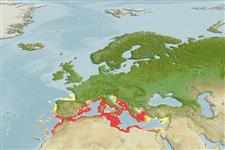>
Anguilliformes (Eels and morays) >
Congridae (Conger and garden eels) > Congrinae
Etymology: Gnathophis: Greek, gnathos = jaw + Greek, ophis = serpent (Ref. 45335).
Environment: milieu / climate zone / depth range / distribution range
Ökologie
seewasser demersal; tiefenbereich 75 - 800 m. Subtropical; 46°N - 30°N, 18°W - 36°E
Eastern Atlantic: southern Portugal to Morocco, including the Mediterranean.
Size / Gewicht / Alter
Maturity: Lm ? range ? - ? cm
Max length : 60.0 cm TL Männchen/unbestimmt; (Ref. 3397); common length : 35.0 cm TL Männchen/unbestimmt; (Ref. 3397)
Found on muddy or sandy bottoms of the continental slope. Adults feed on benthic invertebrates and probably small fishes.
Life cycle and mating behavior
Maturities | Fortpflanzung | Spawnings | Egg(s) | Fecundities | Larven
Bauchot, M.-L. and L. Saldanha, 1986. Congridae (including Heterocongridae). p. 567-574. In P.J.P. Whitehead, M.-L. Bauchot, J.-C. Hureau, J. Nielsen and E. Tortonese (eds.) Fishes of the north-eastern Atlantic and the Mediterranean. volume 2. UNESCO, Paris. (Ref. 6521)
IUCN Rote Liste Status (Ref. 130435)
Bedrohung für Menschen
Harmless
Nutzung durch Menschen
Fischereien: weniger kommerziell
Tools
Zusatzinformationen
Download XML
Internet Quellen
Estimates based on models
Preferred temperature (Ref.
123201): 13.2 - 15.3, mean 14.2 °C (based on 134 cells).
Phylogenetic diversity index (Ref.
82804): PD
50 = 0.5000 [Uniqueness, from 0.5 = low to 2.0 = high].
Bayesian length-weight: a=0.00072 (0.00044 - 0.00120), b=3.14 (2.99 - 3.29), in cm total length, based on LWR estimates for this species & (Sub)family-body (Ref.
93245).
Trophic level (Ref.
69278): 3.5 ±0.0 se; based on diet studies.
Widerstandsfähigkeit (Ref.
120179): mittel, Verdopplung der Population dauert 1,4 - 4,4 Jahre. (Preliminary K or Fecundity.).
Fishing Vulnerability (Ref.
59153): Moderate vulnerability (44 of 100).
Nutrients (Ref.
124155): Calcium = 41.5 [10.4, 118.8] mg/100g; Iron = 0.952 [0.331, 3.887] mg/100g; Protein = 18.4 [15.5, 21.2] %; Omega3 = 0.363 [0.165, 0.986] g/100g; Selenium = 37.2 [7.8, 101.1] μg/100g; VitaminA = 9.08 [2.59, 31.39] μg/100g; Zinc = 0.617 [0.320, 1.190] mg/100g (wet weight);
